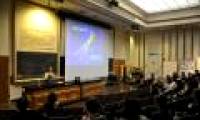
American experts develop carbon materials based on sheet-like nanostructures that are stronger than diamonds in terms of intensity-to-density ratio.

Scientists have found a solution to the invisible wings encountered in the Glasswing butterfly.

In the morning of August 1, in Quy Nhon City, Binh Dinh Province, Center for Theoretical Physics, Institute of Physics in collaboration with Quy Nhon University, organized the 36th

Researchers at Harvard University demonstrated microchips containing 145 solid oxide fuel cells or fuel cell chips (Fuel cells on-a-chip) to replace small batteries.

Correspondent ANSA said it was the result of a 10-year study by scientists at Clarkson University in Potsdam, New York.

A research group led by TS. Jinyao Tang of the Department of Chemistry, the University of Hong Kong, has researched and developed the world's first light-driven nanorobot.

Scientists have successfully developed an experimental battery whose design is inspired by ... human gut.

A new fabric uses light to break down organic compounds that make up the stain, being developed by researchers from the Royal Melbourne Institute of Technology (RMIT University) in

Researchers at Princeton University have made a significant breakthrough in improving the brightness and efficiency of LEDs.

Scientists have devised a special material that can be coated on surfaces, keeping them dry or wet, making the surface never need to be cleaned.
 American experts develop carbon materials based on sheet-like nanostructures that are stronger than diamonds in terms of intensity-to-density ratio.
American experts develop carbon materials based on sheet-like nanostructures that are stronger than diamonds in terms of intensity-to-density ratio. Scientists have found a solution to the invisible wings encountered in the Glasswing butterfly.
Scientists have found a solution to the invisible wings encountered in the Glasswing butterfly. In the morning of August 1, in Quy Nhon City, Binh Dinh Province, Center for Theoretical Physics, Institute of Physics in collaboration with Quy Nhon University, organized the 36th
In the morning of August 1, in Quy Nhon City, Binh Dinh Province, Center for Theoretical Physics, Institute of Physics in collaboration with Quy Nhon University, organized the 36th Researchers at Harvard University demonstrated microchips containing 145 solid oxide fuel cells or fuel cell chips (Fuel cells on-a-chip) to replace small batteries.
Researchers at Harvard University demonstrated microchips containing 145 solid oxide fuel cells or fuel cell chips (Fuel cells on-a-chip) to replace small batteries. Correspondent ANSA said it was the result of a 10-year study by scientists at Clarkson University in Potsdam, New York.
Correspondent ANSA said it was the result of a 10-year study by scientists at Clarkson University in Potsdam, New York. A research group led by TS. Jinyao Tang of the Department of Chemistry, the University of Hong Kong, has researched and developed the world's first light-driven nanorobot.
A research group led by TS. Jinyao Tang of the Department of Chemistry, the University of Hong Kong, has researched and developed the world's first light-driven nanorobot. Scientists have successfully developed an experimental battery whose design is inspired by ... human gut.
Scientists have successfully developed an experimental battery whose design is inspired by ... human gut. A new fabric uses light to break down organic compounds that make up the stain, being developed by researchers from the Royal Melbourne Institute of Technology (RMIT University) in
A new fabric uses light to break down organic compounds that make up the stain, being developed by researchers from the Royal Melbourne Institute of Technology (RMIT University) in Researchers at Princeton University have made a significant breakthrough in improving the brightness and efficiency of LEDs.
Researchers at Princeton University have made a significant breakthrough in improving the brightness and efficiency of LEDs. Scientists have devised a special material that can be coated on surfaces, keeping them dry or wet, making the surface never need to be cleaned.
Scientists have devised a special material that can be coated on surfaces, keeping them dry or wet, making the surface never need to be cleaned.









 Strange 'rich people's MSG', once no one bothered to buy it
Strange 'rich people's MSG', once no one bothered to buy it More than 1,000 artifacts unearthed on Mount Wudang
More than 1,000 artifacts unearthed on Mount Wudang Why did Empress Dowager Cixi eat 20 eggs every day, but the chef had to prepare 500?
Why did Empress Dowager Cixi eat 20 eggs every day, but the chef had to prepare 500? 8 mystical medieval books that are even scarier the more you read them
8 mystical medieval books that are even scarier the more you read them The majestic natural scenery is overwhelming on the most dangerous road in the world
The majestic natural scenery is overwhelming on the most dangerous road in the world Strange wood with the ability to change color: Ranked among the world's top in hardness and durability, Vietnam also grows it
Strange wood with the ability to change color: Ranked among the world's top in hardness and durability, Vietnam also grows it What's inside the world's largest Three Gorges Dam?
What's inside the world's largest Three Gorges Dam? The Y chromosome is gradually disappearing, predicting that men have a new sex gene
The Y chromosome is gradually disappearing, predicting that men have a new sex gene